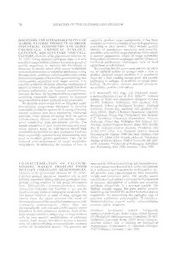
Discovery and sustainable supply of marine natural product as drugs, industrial compounds and agrochemicals ; chemical ecology, genetics, aquaculture and cell culture PDF
Preview Discovery and sustainable supply of marine natural product as drugs, industrial compounds and agrochemicals ; chemical ecology, genetics, aquaculture and cell culture
76 MEMOIRS OF THE QUEENSLAND MUSEUM DISCOVERY AND SUSTAINABLE SUPPLY OF optimally produce target compounds, it has been MARINE NATURAL PRODUCTS AS DRUGS, necessarytoexamineanumberofkeybiologicalissues INDUSTRIAL COMPOUNDS AND AGRO- pertaining to each species. These include genetic CHEMICALS: CHEMICAL ECOLOGY, identity of populations supplying seed material, GENETICS, AQUACULTURE AND CELL correlateswith variabletarget metabolitebiosynthesis CULTURE.MemoirsoftheQueenslandMuseum44: in natural populations, origin of target metabolite 76. 1999:- Using chemical ecological clues, it is now biosynthesis(symbiontorsponge), and theefficacyof possibletotargethabitatsandeco-taxonomicgroupsof artificial production techniques (sea or land marine organisms to increase the likelihood of aquaculture orcell culture). discovery ofspecies which elicit natural compounds Weconcludethattheguess-work cannowbetaken withchemotherapeuticorindustrialapplication. Using out of artificial culture of sponges with a view to thesameclues,combinedwithGeographic Information produce desirable natural products. It is possible to Systeminterrogationofthebenthicgeomorphologyand select for a high yielding culture stock and provide opocsesainbolgertaopihdyentaisfsyoclioactaetdionwsitahllotawrignegtrsepceoclileesc,tioint oifs tbeolcihtneisq.uesOtoPoernifhearnac,e bmiaorsiynntehesniastuorraltarpgreotdumcettsa,- species ofinterest. The information gained from both acfiiucuftitre, genetics, cellculture. primary collections and focused recollections, provides the basis for hypothesis-driven experiments C.N. Battershitt* M.J. Page, A.R. Duckworth (email: examining sustainable supply options for extracted a.duekworth(wniwa.cri.nz) £ K.A. Miller**, National targWetemdeetsacbroilbietersecwehnterreessuyltnsthfersoismiasnnointtpergarcattiecdabmluel.ti- I1n4s-t9it0u1t,e oKftiWbaitmeire,anWdelAltimnogstpohne,riNceRweseZaeraclha,ndP;.O.PB.Ro.x disciplinary programme designed to develop Bergquist, School of Biological Sciences, Auckland sustainableproduction options fora variety ofmarine University, Private Bag, Auckland, New Zealand: J,W. natural products that have interesting biological Blunt, M.H.G. Munro, ChemistryDepartment University activities. Three species of sponge from the genera ofCanterbury, PrivateBag, Christchurch, NewZealand: Lissode/uloryx, Mycalc and Latruneulia, produce P.T. Northcote, Chemistry Department. Victoria novel metabolites with anti-tumour activity. The University, Private Bag, Wellington, New Zealand; DJ. natural abundance ofeach would not support a prod- Newman, NaturalProducts Branch, Bldng 1052, RmI0M9D, uction industry based on wild harvest should their Box B, National Cancer Institute, Frederick, metabolitesbe required fordrug production. Each has 21702-J201, USA; S.A. Pomponi, Harbor Branch been successfully cultured in-sea demonstrating very OceanographicInstitute, 5600 OldDixie Highway, Fort good to excellent growth parameters. Each can be Pierce. FL 34946, USA; Present addresses: ^Australian cultured with maintenance of target metabolite InstituteofMarineScience, PMB3, TownsvilleMC, Qkt, biosynthesis. In addressing the question of how to 4810,Australia; **UniversitvofWollongong, Northf/elds Ave, Wollongong, NSW2500, Australia; 1June 1998. CHARACTERIZATION OF CALCIUM- separated by SDS polyacrylamidegel electrophoresis. BINDING MATRIX PROTEINS FROM Asingleproteinwasdetectedin5". wells'u twoproteins DISTINCT CORALLINE DEMOSPONGES. inA. willeyana, and four proteins in Vaceletia n. sp.. Memoirs ofthe Queensland Museum 44: 76. 1999:- All proteins were characterized by their molecular Calcificd sponges played an important role as reef weight and isoelectric point. The soluble matrix building organisms during different geological lime constituentsofeachspeciesweretestedfortheirpotential periods. Living relatives of this group investigated to decrease precipitation of calcium and strontium here, Spirastrella (Acanthoehaetetes) wellsi, carbonate, respectively, in a saturated solution. The Astrosclera willeyana and Vacetetia n. sp., can be findings strongly suggest that these soluble proteins found in cryptic niches ofindopacific coral reefs. The functionasthetemplate forskeletal formationand are first known relatives of some of these sponges are responsible for determining the particular type of known since the upper permian.The mode of calcium carbonate polymorphs. O Porifera, biomineralizationoftheexaminedspeciesseemstobe biomineralization, organic matrix, calcium-binding extremely conservative, since they are proteins, calcite. aragonitc. phylogenetically very old and exhibit merely minor alterations in their calcareous skeletons. Each ofthe Matthias Bergbauer (email: berggaji@ three species exhibits a unique type ofbasal skeleton mailszrz.zrz.tu-berlin.de), Robert Lange, Ulrich Szewzyk, with its own specific modifications of carbonate FGOkologiederMikroorganismen,Franklinsh\29, OE5, carryrsatyalso.fEcaaclhciuspme-cbiiensdiwnagsmsahcorwonmotloechualveesaesnpcelcoisfeidc JToeeahcnhiismcheReiUtnnievre,rsiItndstt,Be&rlinM,u1s0e5u8m7 BfeurrlinG,eoGleorgmiacny&; within its intraskeletal matrix. The proteins are Paidontologie, Goldschmidstr. 3, Universitdt Gottingen, 37077Gottingen, Germany; IJune 1998
